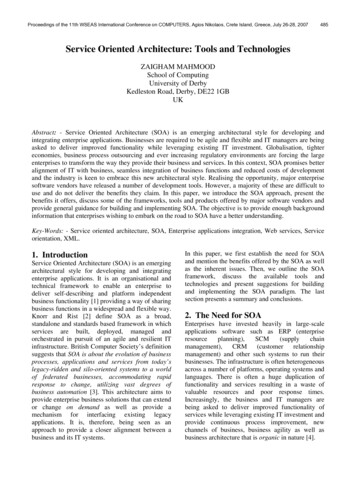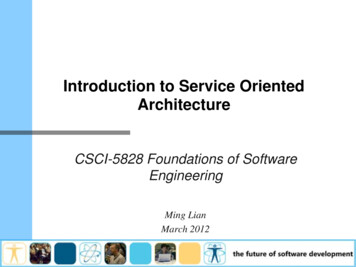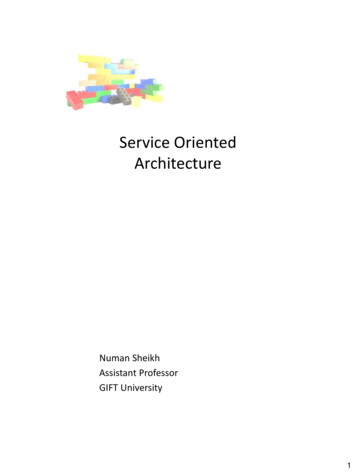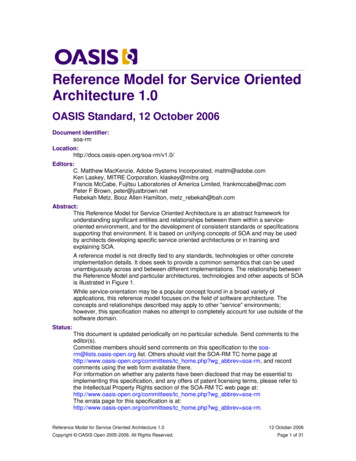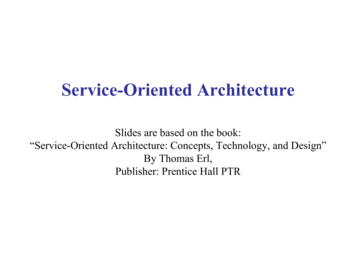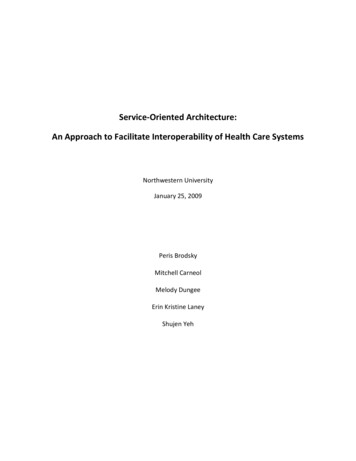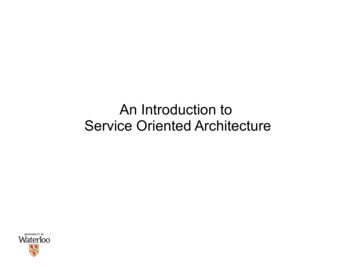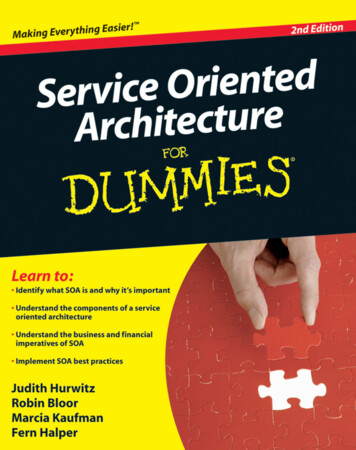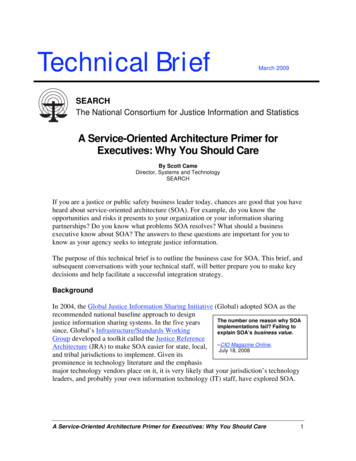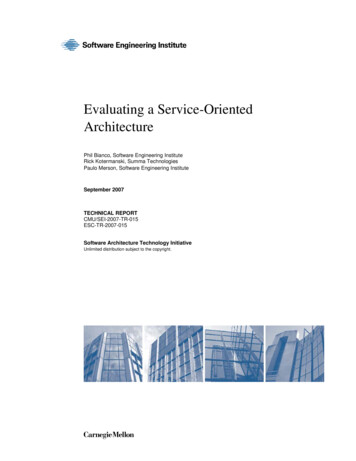
Transcription
Evaluating a Service-OrientedArchitecturePhil Bianco, Software Engineering InstituteRick Kotermanski, Summa TechnologiesPaulo Merson, Software Engineering InstituteSeptember 2007TECHNICAL REPORTCMU/SEI-2007-TR-015ESC-TR-2007-015Software Architecture Technology InitiativeUnlimited distribution subject to the copyright.
This report was prepared for theSEI Administrative AgentESC/XPK5 Eglin StreetHanscom AFB, MA 01731-2100The ideas and findings in this report should not be construed as an official DoD position. It is published in theinterest of scientific and technical information exchange.This work is sponsored by the U.S. Department of Defense. The Software Engineering Institute is a federallyfunded research and development center sponsored by the U.S. Department of Defense.Copyright 2007 Carnegie Mellon University.NO WARRANTYTHIS CARNEGIE MELLON UNIVERSITY AND SOFTWARE ENGINEERING INSTITUTE MATERIAL ISFURNISHED ON AN "AS-IS" BASIS. CARNEGIE MELLON UNIVERSITY MAKES NO WARRANTIES OFANY KIND, EITHER EXPRESSED OR IMPLIED, AS TO ANY MATTER INCLUDING, BUT NOT LIMITEDTO, WARRANTY OF FITNESS FOR PURPOSE OR MERCHANTABILITY, EXCLUSIVITY, OR RESULTSOBTAINED FROM USE OF THE MATERIAL. CARNEGIE MELLON UNIVERSITY DOES NOT MAKEANY WARRANTY OF ANY KIND WITH RESPECT TO FREEDOM FROM PATENT, TRADEMARK, ORCOPYRIGHT INFRINGEMENT.Use of any trademarks in this report is not intended in any way to infringe on the rights of the trademark holder.Internal use. Permission to reproduce this document and to prepare derivative works from this document for internal use is granted, provided the copyright and "No Warranty" statements are included with all reproductions andderivative works.External use. Requests for permission to reproduce this document or prepare derivative works of this document forexternal and commercial use should be addressed to the SEI Licensing Agent.This work was created in the performance of Federal Government Contract Number FA8721-05-C-0003 withCarnegie Mellon University for the operation of the Software Engineering Institute, a federally funded researchand development center. The Government of the United States has a royalty-free government-purpose license touse, duplicate, or disclose the work, in whole or in part and in any manner, and to have or permit others to do so,for government purposes pursuant to the copyright license under the clause at 252.227-7013.For information about purchasing paper copies of SEI reports, please visit the publications portion of our Web ml).
Table of 1.1 Audience for This Report121.222345Structure of This ReportWhat Is Service-Oriented Architecture?2.1 SOA and Web Services342.24Drivers for SOAStakeholders, Quality Attributes, and Architecture Representation for SOA3.1 Stakeholders773.2Quality Attribute Requirements93.3Architecture Description of an SOA10SOA Architectural Approaches4.1 SOA Communication Approaches13134.24.1.1 SOAP-Based Web Services4.1.2 REST4.1.3 Messaging SolutionsIntegration Approach – Direct Point-to-Point Versus ESB131618194.3Business Process Execution Language (BPEL)224.4Static Versus Dynamic Web Services234.5Emerging SOA-Focused Technologies25SOA Design Questions That Affect Quality Attributes5.1 What Is Known About The Target Platform?27275.25.1.1 Quality Attribute Discussion5.1.2 Sample Evaluation QuestionsSynchronous or Asynchronous Services?2728295.35.2.1 Quality Attribute Discussion5.2.2 Sample Evaluation QuestionsCoarse- or Fine-Grained Services?2930305.45.3.1 Quality Attribute Discussion5.3.2 Sample Evaluation QuestionsWhat Are the Strategies For Exception Handling and Fault Recovery?3131325.55.4.1 Quality Attribute Discussion5.4.2 Sample Evaluation QuestionsHTTPS or Message-Level Security?3333345.65.5.1 Quality Attribute Discussion5.5.2 Sample Evaluation QuestionsHow is Service Authentication Managed?3535365.6.15.6.23636Quality Attribute DiscussionSample Evaluation QuestionsSOFTWARE ENGINEERING INSTITUTE i
5.7How is Service Access Authorization Performed?375.85.7.1 Quality Attribute Discussion5.7.2 Sample Evaluation QuestionsIs XML Optimization Being Used?3838385.95.8.1 Quality Attribute Discussion5.8.2 Sample Evaluation QuestionsIs a Service Registry Being Used?3838395.9.1 Quality Attribute Discussion5.9.2 Sample Evaluation Questions5.10 How Are Legacy Systems Integrated?4040415.10.1 Quality Attribute Discussion5.10.2 Sample Evaluation Questions5.11 Is BPEL Used For Service Orchestration?4141425.11.1 Quality Attribute Discussion5.11.2 Sample Evaluation Questions5.12 What Is the Approach for Service Versioning?4243445.12.1 Quality Attribute Discussion5.12.2 Sample Evaluation Questions6SOA Architecture Evaluation Example6.1 Architecture Evaluation Using The ATAM444447476.2Sample Application496.36.2.1 Functionality6.2.2 Architecture Description6.2.3 Quality Attribute ScenariosArchitectural Approaches495053566.4Architectural Analysis567Conclusion618Feedback63Appendix A Sample SOA General Quality Attribute Scenarios65Appendix B Glossary of Technical Terms and Acronyms67Appendix C Acronym List71References75ii CMU/SEI-2007-TR-015
List of FiguresFigure 1: SOA and SOA Technologies4Figure 2: RPC-Encoded Interaction14Figure 3: Document-Literal Interaction15Figure 4: Simplified Comparison of ESB and Point-to-Point Integration Approaches20Figure 5:23Static Binding ExampleFigure 6: Dynamic Binding Example24Figure 7: Https Security (from the work of Mitchell [Mitchell 2005])34Figure 8: Message-Level Security (from the work of Mitchell [Mitchell 2005])35Figure 9: Basic Operations of Adventure Builder (UML Use Case Diagram)50Figure 10: Top-Level Runtime View of the Adventure Builder Architecture51Figure 11: Runtime View with Exemplar External Services52Figure 12: Sequence Diagram for Placing an Order52SOFTWARE ENGINEERING INSTITUTE iii
iv CMU/SEI-2007-TR-015
List of TablesTable 1: Comparison of RPC-Encoded and Document-LiteralApproaches16Table 2: WS-Reliability and WS-ReliableMessaging—Who Is Who19Table 3: Comparison of Synchronous and Asynchronous Services29Table 4: Quality Attribute Scenarios for the Adventure Builder Application53Table 5: Architectural Analysis for Scenario 257Table 6: Architectural Analysis for Scenario 458Table 7: Architectural Analysis for Scenario 559Table 8: Architectural Analysis for Scenario 960SOFTWARE ENGINEERING INSTITUTE v
vi CMU/SEI-2007-TR-015
AcknowledgementsWe want to thank the following people for their thoughtful feedback and discussion that greatlyimproved the quality of this report: Felix Bachmann, Sri Bala, Eric Hohman, Rick Kazman, MarkKlein, Richard Koch, Grace Lewis, Ed Morris, Linda Northrop, Scott Parker, and SoumyaSimanta.SOFTWARE ENGINEERING INSTITUTE vii
viii CMU/SEI-2007-TR-015
AbstractThe emergence of service-oriented architecture (SOA) as an approach for integrating applicationsthat expose services presents many new challenges to organizations resulting in significant risksto their business. Particularly important among those risks are failures to effectively address quality attribute requirements such as performance, availability, security, and modifiability. Becausethe risk and impact of SOA are distributed and pervasive across applications, it is critical to perform an architecture evaluation early in the software life cycle. This report contains technical information about SOA design considerations and tradeoffs that can help the architecture evaluatorto identify and mitigate risks in a timely and effective manner. The report provides an overview ofSOA, outlines key architecture approaches and their effect on quality attributes, establishes anorganized collection of design-related questions that an architecture evaluator may use to analyzethe ability of the architecture to meet quality requirements, and provides a brief sample evaluation.SOFTWARE ENGINEERING INSTITUTE ix
x CMU/SEI-2007-TR-015
1 IntroductionService-oriented architecture (SOA) is a very popular architecture paradigm for designing anddeveloping distributed systems. SOA solutions have been created to satisfy business goals thatinclude easy and flexible integration with legacy systems, streamlined business processes, reducedcosts, innovative service to customers, and agile adaptation and reaction to opportunities andcompetitive threats.One of the most valuable software engineering principles is to introduce inspection points into thesoftware life cycle. Software architecture evaluation is a particularly important inspection point,because architecture is the bridge between business goals and the software system. Choosing anddesigning an architecture that satisfies functional as well as quality attribute requirements (e.g.,availability, security, and performance) is vital to the success of the system. Architectural decisions have a deep and broad effect on downstream development stages. Early evaluation of therequirements and the architecture saves time and money, because fixing defects once the code isfielded is at least three times more costly [McConnell 2001].The goal of this report is to offer practical information to assist the architecture evaluation of asystem that uses the SOA approach. We provide guidance on important aspects of the architectureevaluation activity, such as enlisting stakeholders, describing the architecture, identifying architectural approaches, and probing the architects with questions about the architecture. The systemspecific business goals and requirements dictate how the architecture will be probed by theevaluation team and determine the types of questions that should be asked.This report does not introduce a new method for architecture evaluation. The Architecture Tradeoff Analysis Method (ATAM )—developed by the Carnegie Mellon Software Engineering Institute (SEI)—is used as the basis for defining the activities and information that are important foran architecture evaluation of a system that uses an SOA approach. While we use the ATAM, webelieve the information provided will be useful regardless of the evaluation method employed.In SOA solutions there are service providers—elements offering services to be used by others—and service users—elements that invoke services provided by others. These categories are not mutually exclusive. A service provider may use other services, and a service user may provide a service interface. This report is targeted at the evaluation of the software architecture at the levelwhere it describes the integration of these elements through services. This evaluation at the service integration level does not replace the need to evaluate the internal design of each service userand provider.In this report, we do not address the evaluation of business strategy alignment, risk management,cost benefit analysis of technology adoption, product and vendor selection, or skill development. Architecture Tradeoff Analysis Method, ATAM, and Carnegie Mellon are registered in the U.S. Patent and TrademarkOffice by Carnegie Mellon University.SOFTWARE ENGINEERING INSTITUTE 1
We focus on the technical considerations of evaluating the architecture of a specific system thatuses the SOA approach.1.1 AUDIENCE FOR THIS REPORTThe report is aimed at software architects using the SOA approach and anyone concerned withevaluating SOA solutions. The technical discussion presumes some familiarity with Web servicestechnology and distributed software development.The report should be particularly useful to an architecture evaluation team evaluating an SOAbased architecture using the ATAM or a similar method. It will help them define an appropriategroup of stakeholders, formulate important quality attribute requirements, identify architecturalapproaches used in the solution, understand how those approaches affect system qualities, andprobe the architecture about SOA-specific design concerns. The report can also guide SOA architectural choices made by software architects in the planning and designing phases.1.2 STRUCTURE OF THIS REPORTSection 2 of the report defines SOA and Web services from the point of view of software developers. Section 3 discusses key aspects of any architecture evaluation: selecting stakeholders toparticipate in the evaluation, specifying quality attribute requirements that are important in SOA,and describing the architecture of an SOA-based system. Sections 4 and 5 are the core of the report. Section 4 describes architectural approaches for SOA-based systems and their tradeoffs. Section 5 provides a list of design questions that influence quality attributes and can be used to probethe architecture during the evaluation. This section also contains references to general quality attribute scenarios described in Appendix A. Section 6 is a sample application of the guidelines inSections 3, 4, and 5. Section 7 has our concluding remarks.The report contains many technical terms and acronyms used by the SOA community. We provide a glossary of technical terms and acronyms in Appendix B to avoid extensive explanations inthe report text. We provide a more extensive acronym list in Appendix C that includes both technical and SEI-specific acronyms used in the report.2 CMU/SEI-2007-TR-015
2 What Is Service-Oriented Architecture?There are many definitions of SOA but none are universally accepted. What is central to all, however, is the notion of service. For an SOA, a service is self-contained. The service is highly modular and can be independently deployed. is a distributed component.1 The service is available over the network and accessible througha name or locator other than the absolute network address. has a published interface. Users of the service only need to see the interface and can beoblivious to implementation details. stresses interoperability. Service users and providers can use different implementation languages and platforms. is discoverable. A special directory service allows the service to be registered, so users canlook it up. is dynamically bound. A service user does not need to have the service implementation available at build time; the service is located and bound at runtime.These characteristics describe an ideal service. In reality, services implemented in serviceoriented systems lack or relax some of these characteristics, such as being discoverable and dynamically bound.We define SOA as an architectural style where systems consist of service users and service providers. An architectural style defines a vocabulary of component and connector types, and constraints on how they can be combined [Shaw 1996]. For SOA, the basic component types are service user and service provider. Auxiliary component types, such as the enterprise service bus(ESB) and the directory of services, can be used. SOA connector types include synchronous andasynchronous calls using SOAP, bare http, and messaging infrastructure. Many properties can beassigned to these component and connector types, but they are usually specific to each implementation technology. For example, as we will see in Section 5.1, the property “style” for messages inthe Web services technology can be either “RPC” or “document.” Some of the constraints thatapply to the SOA architectural style are Service users send requests to service providers. A service provider can also be a service user. A service user can dynamically discover service providers in a directory of services. An ESB can mediate the interaction between service users and service providers.1In practice a service implementation may consist of a collection of components. They work together to deliver the functionality the service represents.SOFTWARE ENGINEERING INSTITUTE 3
2.1 SOA AND WEB SERVICESAlthough much has been written about SOA and Web services, there still is some confusion between these two terms among software developers. SOA is an architectural style, whereas Webservices is a technology that can be used to implement SOAs. The Web services technology consists of several published standards, the most important ones being SOAP and WSDL. Othertechnologies may also be considered technologies for implementing SOA, such as CORBA. Although no current technologies entirely fulfill the vision and goals of SOA as defined by mostauthors, they are still referred to as SOA technologies. The relationship between SOA and SOAtechnologies is represented in Figure 1. Much of the technical information in this report is relatedto the Web services technology, because it is commonly used in today’s SOA implementations.Figure 1:SOA and SOA Technologies2.2 DRIVERS FOR SOAIn large organizations, the following types of organizational, business, and technology changesdrive a desire to reap the benefits of SOA: integration with legacy systems corporate mergers realignment of responsibilities through business reorganizations changing business partnerships (e.g., relationships with suppliers and customers) modernization of obsolete systems for financial, functional, or technical reasons acquisition or decommission of software products sociopolitical forces related to or independent of the drivers cited above4 CMU/SEI-2007-TR-015
These forces lead to SOA because they involve significant application integration efforts. Whenan integrated application changes, risky and costly modifications to other applications are frequently required. As system interconnections become more pervasive and the pace of businessand process changes increases, the inability to integrate efficiently can cause the failure of a business. SOA is seemingly ideal for these situations.Distributed systems technologies of the past, such as CORBA, didn’t achieve broad adoption inpart because standards were not widely endorsed by CORBA vendors. More recent SOA technologies, such as Web services, seem to be off to a better start as they begin to be widely adopted.One possible explanation for the change in attitude is that the need to interoperate with applications outside the scope of a given organization is becoming more vital. The notion of software asa service (SaaS) delivery is intended to allow organizations to selectively purchase, mix, match,and change sources of services to their business advantage. The goal of the service-oriented approach is to enable the composition of new or existing services and applications in a technologically heterogeneous environment. However, many of the issues and concerns encountered andaddressed in distributed systems designs over the past 20 to 30 years also apply directly to SOA.Significant shortcomings of integration approaches are related to the independent entropy (ormovement to disorder) of connected but separately managed applications. Since many technicalissues remain, a careful evaluation of a system’s design decisions is important to ensure that anSOA solution can attain the benefits advertised by proponents of the SOA approach.SOFTWARE ENGINEERING INSTITUTE 5
6 CMU/SEI-2007-TR-015
3 Stakeholders, Quality Attributes, and Architecture Representation for SOAIn any software architecture evaluation, three activities are critical to success: (1) selecting a representative constituency of stakeholders to provide input in the evaluation; (2) specifying the quality attribute requirements that derive from business goals in a precise way; and (3) describing thearchitecture in an expressive and comprehensive way. This section discusses how these activitiesshould be carried out when the architecture in question is SOA based.3.1 STAKEHOLDERSThe architecture evaluation should allow participants to express concerns and see how their concerns are addressed. A broader constituency of stakeholders decreases the risk of overlooking important architectural concerns. One of the challenges of eliciting quality attribute requirementsfor a system is that it may not be possible to know all the stakeholders. Thi
Service-oriented architecture (SOA) is a very popular architecture paradigm for designing and developing distributed systems. SOA solutions have been created to satisfy business goals that include easy and flexible integration with legacy systems, streamlined business processes, reduced

